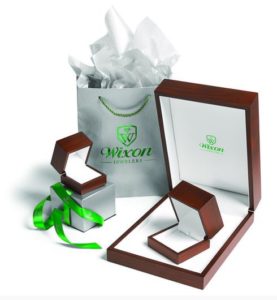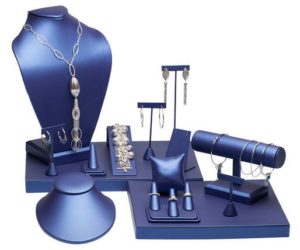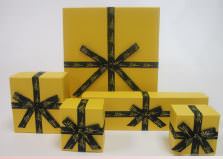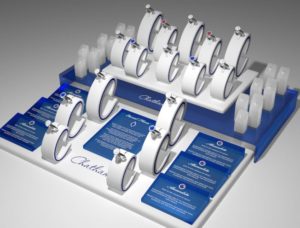On Display
Presentation is about surprising and delighting. It’s about everything the customer encounters, and it should impact all of the senses that engage us. You only have a matter of seconds to capture someone’s attention, and displays in particular play a critical role in attracting customers to the case.
“Displays are silent sales associates and good displays make people want to ask about the merchandise,” advocates Patti Levi, vice president of sales for GemPak, a Quality Gold company in Dallas, Texas.
 Here are a few key strategies to keep in mind.
Here are a few key strategies to keep in mind.
Tell Stories
Good storytellers know how to set scenes to capture attention and draw their audience in. That’s exactly what effective visual design and merchandising does for the retailer, relating the brand and products back to the consumer, explains Pam Levine, Levine Luxury Branding, New York. “Use the physical elements that make up your store, the merchandise and how it’s displayed to stimulate customers emotionally to buy. The goal is to make shopping inviting and fun.”
Levine advocates retailers create themes that can run throughout their showcases. Using color as an example, she cites many ways retailers can express a theme. “You can go beyond just popping in color with displays and fabric by also incorporating other touch points like quotes related to color, a thread you can carry online.” She also suggests adding colorful art and fashion to the mix. In fact, she believes the industry doesn’t talk enough about fashion and its relationship to jewelry. “There’s a huge opportunity to discuss color in the context of fashion and how jewelry works with the latest styles.”
Experts advocate well placed signage in showcases to guide customers. “Can everything in this case be personalized? Is everything in this case at the price point I’m looking to reach? Signage can identify key information for customers,” says Emily Graffagnino, visual merchandising and packaging manager for Stuller, Lafayette, Louisiana. And, when using props, less is more, says Andrew Kaplan, vice president of sales for Rocket Redbox, Bronx, New York. “Be mindful where you’re placing the focus. Props should not compete with the jewelry.”
Create Groupings
Make sure your store is not like a run on sentence that keeps going and going and is difficult for shoppers to comprehend all that you have to offer, advises Graffagnino. “Arrange your merchandise into digestible groupings.”

Retailers must understand their core merchandise groups and determine traffic flow as it pertains to store type and location, says Denise Cabrera, product manager, display and packaging, Rio Grande, a Richline company based in Albuquerque, New Mexico. “Observe how people move through your store. Get out from behind the counter to see what they see. How is the store set up, from broad categories to subcategories? There’s a lot going on to translate. Are displays too high or too low? Are there too many things in the case that make it difficult for customers to focus? Are you using risers and different levels to differentiate product? It’s important for retailers to build focal points.”
Most importantly, your showcases must be easy for both the customer and sales associate to navigate. “A sales associate does not want to be knocking things over to take a piece out of the case,” says Kaplan. “If the showcase is not easy to work, the associate will not be inspired to show it.” He notes that magnetic displays have been a popular solution to keeping jewelry in place. Levi also advocates GemPak’s Ice Grip line of displays. “Nothing falls off! The fabric is made in a way that keeps product from sliding.”
Light Your Way
Lighting cannot be an afterthought. There are many types to choose from and a lot to consider regarding their impact on your display from tint to temperature. It’s important to get a lighting consultant involved as you’re putting it all together, suggests Levine. “Lighting alone can update a showcase easily and quickly.”
Kaplan is a proponent for LED lighting, which many retailers already favor. “LED provides cost savings in electricity and longer lifespan of display elements. Halogen lights can get up to 120 degrees in a showcase, which not only cooks your display pieces, it makes it hot in your store, adding to air conditioning costs.”
Your showcases must be the brightest things in your store, reminds Kaplan, who advocates spotlighting, especially in storefront windows. Lighting highlights architectural elements, product qualities and creates virtual space that impacts how we feel about a product and whether we’ll buy it. And you can really have some fun with lighting if it’s done right, says Graffagnino, who notes that Stuller uses rotating lights for its gem cases that give the stones movement and shows customers how light reflects off and through them.
 Upkeep & Update
Upkeep & Update
Consultants recommend sprucing up displays at least once or twice a year, especially before the big holiday season. “If displays look mismatched and beyond repair and cleaning, it’s time to replace,” stresses Levi.
Cleanliness means a lot. “Something as basic as fingerprints, dust and clutter are turn-offs,” says Kaplan, who suggests jewelers assign sales associates a section of showcases to manage. “Let them take pride of ownership in keeping them clean and properly stocked. The store staff should be included in the process.” He also advocates changing displays, seasonally or for special occasions.
To evaluate your store, Graffagnino suggests: “Walk in first thing in the morning and ask yourself ‘how do I feel?’ Are you excited, anxious, etc? If you’re anything but optimistic it’s probably time for a change. You can also look at how long jewelry has been sitting in your cases—six months, 12 months? It may be time for a refresh. Move things around to give your store a different feel. Place items you want to sell in high traffic areas.”
Try New Things
As retail consultants are telling us, it’s no longer about the store, but the experience the retailer provides. Retailers that are redefining boundaries, creating interactive and personally relevant jewelry experiences are on the cutting edge of this mega trend.
With customization a key service retailers are providing, Graffagnino suggests jewelers who offer custom design should have a separate area to consult that could include a technology solution like Stuller’s CounterSketch™ design software, a side-by-side salesman for questions and guidance, and prototypes for customers to get ideas for their creation. “The custom process should make customers truly feel like they’re an integral part of what they’re creating.”
Levine notes that there are retailers with bench jewelers on site who are no longer relegated to the backroom, but rather showcased on the sales floor where customers can see the process and meet with designers and goldsmiths to create a custom piece.

The goal is to be more interactive, more customer centric in your approach. A great example of what is possible was seen at the Plumb Club pavilion, JCK Las Vegas at the Chatham booth, says Levine of her client. “We worked with the Plumb Club to design the showcases to be open, no glass, so that customers could play and try on the jewelry.”
The endeavor was a great success, reports Monica McDaniel, communications manager for the San Marcos, California man-made gem company. “We wanted to create an experience to engage our customers. People actually sought us out because they heard the buzz. Our sales force is very attentive so no one is left alone. This is how we sell at other shows, but was entirely new for the Plumb Club.” New to the Plumb Club, Chatham reported a record year!










